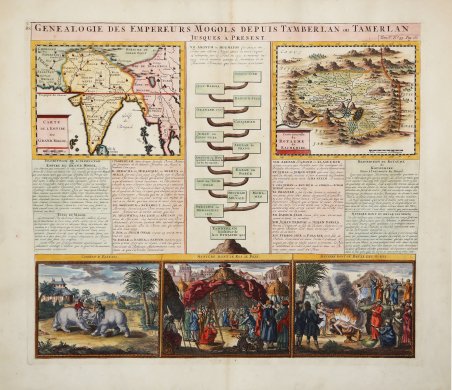Foglio con incisioni e testo, incluso nell'Atlas Historique, pubblicato ad Amsterdam tra il 1705 e il 1720. L'atlante, in 7 volumi, è innovativo per la sua epoca perché combina le mappe geografiche con incisioni e informazioni di carattere storico, etnografico e araldico. L'incisione include una coppia di mappe, un albero genealogico e 3 vignette che rappresentano la vita degli indigeni dell'Impero Mogol. Le mappe superiori mostrano l'Impero del Grande Mogol e il Regno di Kachimere. Il centro include l'albero genealogico della dinastia Mogol, cominciando da Tamberlan nel 1402 e finendo con Ferrog Sier. Nella parte inferiore: 2 combattenti su Elefanti, una scena nella corte reale e l'usanza di bruciare i morti. ' Include una spiegazione dettagliata in francese. Henri Abraham Chatelain (1684 - 1743) era un pastore ugonotto di origini parigine. È meglio conosciuto come cartografo olandese e più specificamente per il suo contributo cartografico nell’Atlas Historique ' in sette volumi, pubblicato ad Amsterdam tra il 1705 e il 1720. Innovativo per il suo tempo, l'Atlas Historique ' combinava incisioni e opere d'arte con studi di geografia, storia, etnologia, araldica e cosmografia. Alcuni studiosi suggeriscono che l'Atlas Historique ' non fu compilato esclusivamente da Henri Chatelain, come si crede comunemente, ma piuttosto fu un'impresa familiare che coinvolse Henri, suo padre Zacharie e suo fratello, sempre Zacharie. Acquaforte, finemente colorata a mano, in ottimo stato di conservazione. Interesting pair of maps, Genealogical tree and 3 indigenous views of the Mogol Empire, from Chatelain's Atlas Historique. Taken from Atlas Historique published in Amsterdam between 1705 and 1720. In 7 volumes, this Atlas is innovative for his time, because combines maps and engravings and informations of geography, history, ethnology, heraldry. This is a genealogy of the Mughal rulers of Central Asia and India. The genealogy starts with Tamerlane, the founder of the Mughal Dynasty, and includes such notable figures as Babur, Akbar, Aurangzeb and Furrksiyar, who was the incumbent Mughal Emperor at the time of the Atlas’ publication. The genealogy is itself part of a larger collage. It is flanked to the left and right by maps of Mughal India and the Kingdom of Kachimere. Towards the bottom, there are three vignettes which show a couple of dueling elephants, an image of the royal court, and a traditional Mughal death ritual. Henri Abraham Chatelain (1684 - 1743) was a Huguenot pastor of Parisian origins. He is best known as a Dutch cartographer and more specifically for his cartographic contribution in the seminal seven volume ' Atlas Historique, published in Amsterdam between 1705 and 1720. Innovative for its time, the ' Atlas Historique ' combined fine engraving and artwork with scholarly studies of geography, history, ethnology, heraldry, and cosmography. Some scholarship suggests that the ' Atlas Historique ' was not exclusively compiled by Henri Chatelain, as is commonly believed, but rather was a family enterprise involving Henri, his father Zacharie and his brother, also Zacharie. Copper engraving with fine later hand colour, in excellent condition. Cfr.

Scopri come utilizzare
Scopri come utilizzare

